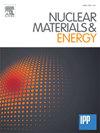Oxidation behaviour of PM-C26M FeCrAl alloy in low-temperature steam 400 – 900 °C
IF 2.7
2区 物理与天体物理
Q1 NUCLEAR SCIENCE & TECHNOLOGY
引用次数: 0
Abstract
Iron-chromium-aluminum (FeCrAl) alloys are the primary candidate for serving as an accident tolerant fuel cladding, replacing zirconium (Zr)-based cladding. This preference stems from the high corrosion resistance under both operating and accident conditions in light water reactors (LWRs). To successfully implement this alloy as a cladding material in LWRs, the corrosion behavior under various conditions needs to be understood. While recent studies have focused on high-temperature steam conditions (>1000 °C) and operating conditions (∼300 °C), there is a notable gap in research exploring the steam temperature range above 300 °C and below 1000 °C. This study specifically investigated the formation of oxide layers on powder metallurgy (PM)-C26M FeCrAl in steam at temperatures ranging from 400 °C – 900 °C. It was found that within the temperature range of 400 °C – 600 °C, a duplex oxide layer emerges, with Fe-oxide in the outer layer and Cr/Al-oxide in the inner layer. At 500 °C, the outer layer consists of α-Fe2O3 crystals with Cr/Al-oxides in the inner layer. The initial occurrence of a single oxide layer mostly comprised of alumina (Al2O3) is observed at 700 °C, remaining consistent from the 700 °C – 900 °C range. The Al2O3 layer is nanocrystalline, but not as thick or as uniform in composition as that observed in high-temperature steam environments. Notably, the Al2O3 layer has Fe, Cr, and molybdenum (Mo) precipitates dispersed throughout. Increasing the temperature decreases the presence of these precipitates in the oxide layer, and an increase in either temperature or time results in an increase in the thickness of Al2O3 layer.
PM-C26M FeCrAl合金在400 ~ 900℃低温蒸汽中的氧化行为
铁铬铝(FeCrAl)合金是替代锆(Zr)基包壳作为耐事故燃料包壳的首选材料。这种偏好源于轻水反应堆(LWRs)在运行和事故条件下的高耐腐蚀性。为了在轻水堆中成功实现该合金作为包层材料,需要了解其在各种条件下的腐蚀行为。虽然最近的研究主要集中在高温蒸汽条件(>1000°C)和操作条件(~ 300°C)上,但在探索300°C以上和1000°C以下蒸汽温度范围的研究中存在明显的空白。本研究专门研究了粉末冶金(PM)- c26m FeCrAl在400°C - 900°C的蒸汽中氧化层的形成。结果表明,在400℃~ 600℃的温度范围内,出现了一层双相氧化层,外层为Fe-oxide,内层为Cr/Al-oxide。在500℃时,外层由α-Fe2O3晶体和内层的Cr/ al氧化物组成。在700°C时观察到主要由氧化铝(Al2O3)组成的单一氧化层的初始出现,在700°C - 900°C范围内保持一致。Al2O3层是纳米晶,但不像在高温蒸汽环境中观察到的那样厚或均匀。值得注意的是,Al2O3层中弥散着Fe、Cr和Mo析出物。升高温度会减少氧化层中这些沉淀的存在,并且温度或时间的升高都会导致Al2O3层厚度的增加。
本文章由计算机程序翻译,如有差异,请以英文原文为准。
求助全文
约1分钟内获得全文
求助全文
来源期刊

Nuclear Materials and Energy
Materials Science-Materials Science (miscellaneous)
CiteScore
3.70
自引率
15.40%
发文量
175
审稿时长
20 weeks
期刊介绍:
The open-access journal Nuclear Materials and Energy is devoted to the growing field of research for material application in the production of nuclear energy. Nuclear Materials and Energy publishes original research articles of up to 6 pages in length.
 求助内容:
求助内容: 应助结果提醒方式:
应助结果提醒方式:


